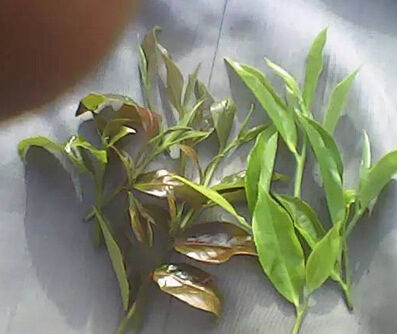
Wild Tea: Initially, there is no artificial cultivation and management.
Tea leaves are prone to variation due to seed growth. The young leaves have no or little hair, with sparse blunt teeth on the leaf edge or no serrations at all. Because the leaves are leathery and thick, it is difficult to roll them into strips, and the raw tea often appears dark green. The main and secondary veins are thick and obvious, and the tea leaves are mostly dark green. The tea is smooth, soft, and heavy in quality, with a deep and unique aroma, and low irritation in taste, but it is sweet with a long and stable sweet aftertaste. Many wild-type tea leaves are bitter and not easy to dissolve. The local ethnic minorities call them bitter tea, which can easily cause diarrhea and is not suitable for drinking. There are relatively few wild-type tea varieties suitable for making tea products.
Abandoned Tea: Initially, it was artificially cultivated and managed, but due to certain factors, it became unmanaged.
Mostly small trees, because of artificial management and dwarfing, which facilitates picking. The young leaves have many silver tips, and the leaf edges have sharper teeth than the wild type, and some have no serrations. The leaf body is thinner than that of wild trees, and the raw tea is mostly dark green or yellow-green. The main and secondary veins are obvious. The tea nature is stronger than that of the wild type, and the tea quality is quite good. The aroma is more pronounced, and the taste is slightly thinner and more intense than that of the wild type. However, what is commonly considered as cultivated wild tea is mostly tea garden tea that was planted after the early Republic of China or before 1950-1985 and then abandoned. All plants of the Camellia family are trees (with main root systems), and they become shrubs only after artificial cutting and asexual reproduction. Many sources of sun-dried green tea in Yunnan belong to abandoned tea, which are tea gardens that have been planted with little artificial management, no artificial fertilizers or pesticides, and only slight weeding and soil turning. The tea age is about fifty or sixty years to a hundred years. The tea varieties vary slightly due to seed growth, with thick leaves, deep color, and aroma and taste between cultivated wild tea and garden tea. The characteristics of abandoned tea mainly lie in combining the advantages of wild tea and garden tea. The aroma is more stable than garden tea but more fragrant than wild tea. The soup quality is not as soft as wild tea, but it is sweeter and more mellow than garden tea. Although the throat feeling is not as restrained as wild tea, the taste is more comprehensive. In terms of subsequent aging value, abandoned tea with more than fifty years of age may not be worse than wild tea.
What local scholars and the tea industry in Yunnan consider good tea varieties are those with high content of inherent substances in the tea leaves, that is, high matrix for oxidation and polymerization reactions. This is significantly different from the Taiwanese market's method of evaluating tea quality based on aroma and taste. Since 1985, improved varieties such as Menghai large-leaf tea, Jinggu large white tea, Yunkang No. 10, Yunkang No. 14, Yunxuan No. 9, Yungui, and Aifeng have been mainly promoted as Pu-erh tea varieties for planting.
General shrub terrace tea gardens
The leaf edges have fine and sharp teeth, and the leaf body is the thinnest. The raw tea is mostly light green or yellow-green. Compared to the previous three, garden tea has the strongest tea nature, and the tea quality is mostly thinner, with the most pronounced aroma and the strongest taste irritation. The sweet aftertaste is quick but short-lived, and the water is thin and sweet but relatively unstable. With the tea variety improvements recognized by Yunnan academia and industry, the trend towards high aroma and light sweetness is very obvious. As the market continues to expand, the green tea-like taste has also been accepted by beginners.
Revelation
With the changes of the times and the development of technological civilization, values and tastes will change. The tea leaves and processes used in each era are different. From extensive wild growth to artificial management and cultivation, from group seed seedlings to asexual cutting propagation, from deep charm, full energy, and heavy quality to strong tea nature, concentrated aroma, and blending levels, from stone mold pressing and sun-drying to machine mold pressing and drying room drying, etc., these changes are not right or wrong, good or bad, but simply change with the times and technological concepts. In the late 1990s, mainly Taiwanese tea people pursued a retro concept, returning to the production of cultivated wild tea, hoping that after fifty years, the next batch of antique tea would appear. However, because the truth of the traditional process before the 1950s has not been traced, whether it can become the flavor of today's antique tea as expected is still uncertain; moreover, after fifty years, whether consumers will still like such a taste is also unknown.